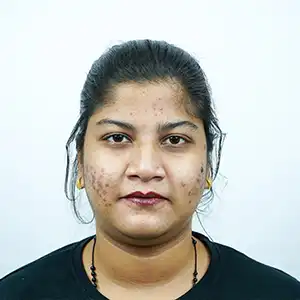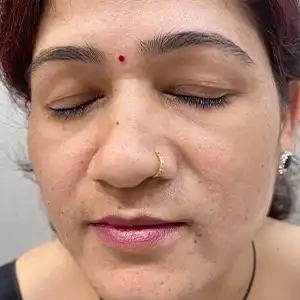
Introduction
Pimples are a common occurrence for everyone at some point. Hormones, stress, heredity, and nutrition are just a few of the possible triggers for pimples.
Pimples can be irritating when they come back again and again. At their worst, they may leave scars that last a lifetime, resulting in anxiety or melancholy.
Whatever method you choose to keep pimples at bay, remember that persistence and patience are the keys to success. While a single pimple may be reduced overnight with a dab of benzoyl peroxide, most treatments take several weeks to show any improvement.
Common Signs & Symptoms Of Dull Complexion
- Dryness or flakiness
- Rough or uneven skin texture
- Excessive oiliness or greasiness
- Enlarged pores
- Dull or lackluster appearance
- Tired or fatigued-looking skin
- Redness or irritation
- Acne breakouts or blemishes
- Uneven skin tone or discoloration.

Dull Skin Treatment Option
- Chemical peels are a cosmetic treatment that can improve the appearance of skin by removing dead, dull skin cells.
- The procedure involves applying a chemical solution to the skin, which causes the top layers of the skin to peel off.
- Chemical peels can be used to treat a variety of skin concerns, including fine lines, wrinkles, acne scars, hyperpigmentation, and sun damage.
- There are three main types of chemical peels: superficial, medium, and deep. The strength and depth of the peel will depend on the specific needs of the patient.
- Superficial peels are the mildest type of peel and only affect the outermost layer of skin. They are typically used to improve skin texture and tone.
- Medium peels penetrate deeper into the skin and can help to improve the appearance of fine lines, wrinkles, and mild acne scarring.
- Deep peels are the strongest type of chemical peel and can help to address more severe skin concerns, such as deep wrinkles and extensive sun damage.
- Chemical peels can cause some temporary side effects, such as redness, swelling, and peeling. However, these side effects typically subside within a week or two.
- It is important to follow proper aftercare instructions following a chemical peel, including avoiding sun exposure and using gentle skincare products
- Carbon peel is a non-invasive cosmetic treatment that uses carbon-based lotion and a laser to improve the appearance of the skin.
- The procedure involves applying a thin layer of carbon lotion to the skin’s surface, which penetrates the pores of the skin.
- A laser is then used to heat the carbon particles, causing them to vaporize and remove impurities from the skin.
- The carbon peel can help to improve skin texture, reduce the appearance of pores, and give the skin a brighter, more youthful appearance.
- Carbon peels are suitable for all skin types and can be particularly effective for those with oily, acne-prone skin.
- The procedure is generally painless, although patients may experience some mild discomfort or heat sensation during the treatment.
- There is no downtime associated with a carbon peel, and patients can resume their normal activities immediately after the procedure.
- It is important to follow proper aftercare instructions following a carbon peel, including avoiding sun exposure and using gentle skincare products.
- Carbon peels can be performed in conjunction with other cosmetic treatments, such as microdermabrasion or chemical peels, for even greater results.
- HydraFacial treatment is a non-invasive skincare procedure that can help to revitalize dull, tired-looking skin.
- The treatment involves using a specialized device to cleanse, exfoliate, and hydrate the skin, while also delivering targeted serums to address specific skin concerns.
- The treatment is customizable, meaning it can be tailored to your individual skin type and concerns.
- The procedure is painless and requires no downtime, meaning you can resume your normal activities immediately after the treatment.
- HydraFacial treatment can help to improve skin texture, reduce fine lines and wrinkles, and promote a brighter, more radiant complexion.
Topical medications
The following are the most often prescribed topical medications for acne:
For mild acne, medications containing retinoic acids or tretinoin are often effective. These may be found in a variety of forms, including creams, gels, and lotions. Adapalene (Differin) and tazarotene are examples of tretinoin (Avita, Retin-A, and others), tazarotene (Tazorac, Avage, others). After three weeks of using it three times a week, you may go back to using it every day after your skin becomes adapted to it. It prevents hair follicles from becoming clogged. Do not use tretinoin and benzoyl peroxide at the same time.
Topical retinoids increase the sensitivity of your skin to the sun. Aside from that, they might create itchy or flaky skin, particularly in persons with darker complexions. Adapalene seems to be a well-tolerated medication.
Excess skin germs are killed, and inflammation and redness are reduced as a result. Use an antibiotic in the morning and an anti-retinol in the evening for a few months until your body adjusts to both. The use of antibiotics in combination with benzoyl peroxide helps prevent the spread of antibiotic resistance among bacteria and other pathogens. Benzoyl peroxide (Benzaclin, Duac, etc.) and erythromycin (with benzoyl peroxide) are two examples (Benzamycin). The use of just topical antibiotics is not advised.
Yeast produces azelaic acid, a naturally occurring acid. It’s antimicrobial, therefore it’s good for you. When used twice daily, azelaic acid cream or gel with 20 percent azelaic acid seems to be as effective as many conventional acne treatments. When you’re pregnant or breastfeeding, you may take prescription azelaic acid (Azelex, Finacea) to help with your symptoms. It may also be used to reduce acne-related discoloration. Skin redness and inflammation are possible side effects.
Salicylic acid, which is available in both wash-off and leave-on forms, may help prevent clogged hair follicles. There aren’t many studies to back up the success of this strategy. Skin discoloration and itching are possible side effects.
Oral medications
For acne, there are a variety of oral medicines available.
Oral antibiotics may be required to treat moderate to severe acne if germs are present. When it comes to treating acne, tetracyclines (such as minocycline and doxycycline) or macrolides are usually the first options considered (erythromycin, azithromycin). In the case of expectant mothers and children under the age of 8, who cannot take tetracyclines, a macrolide may be a choice.
The use of oral antibiotics should be limited to periods that will not lead to the development of resistance. Benzoyl peroxide should be used in conjunction with antibiotics to minimize the development of antibiotic resistance.
Antibiotics seldom have serious negative effects when used to treat acne. These medications do raise your skin’s sensitivity to the sun’s rays.
Topical retinoids increase the sensitivity of your skin to the sun. Aside from that, they might create itchy or flaky skin, particularly in persons with darker complexions. Adapalene seems to be a well-tolerated medication.
The FDA has authorized four oral contraceptive combinations for women who also want to use them for contraception but have acne. These are progestin-estrogen combination products (Ortho Tri-Cyclen 21, Yaz, others). Because you won’t notice results from this therapy for many months, combining it with other acne drugs during the first few weeks is a good idea.
Weight gain, breast discomfort, and nausea are all common adverse effects of combination oral contraceptives. Cardiovascular disease, breast, and cervical cancers are all risks connected with these medicines.
Vitamin A derivative isotretinoin (Amnesteem, Claravis, and other brands) is used to treat acne. People with moderate to severe acne who have not responded to prior therapies may be administered this medication.
Inflammatory bowel illness, depression, and serious birth abnormalities are all possible adverse effects of oral isotretinoin. The FDA must authorize a risk management program for all persons taking isotretinoin. A visit to the doctor frequently will be required for monitoring of adverse effects.
Post-Care Instructions
Here are some post-care instructions to follow after a procedure:
- Avoid using any cleanser on your face for the first 12 hours after the procedure.
- Use only normal water to wash your face during this time.
- If you experience any skin sensitivity, apply a cold compress to the affected area.
- Moisturize your skin adequately at least 3-4 times a day.
- Apply an optimal SPF sunscreen and touch it up every 2-3 hours.
- Wait at least 24 hours before applying makeup.
- Avoid exercising for at least 24 hours after the procedure.
- Stay away from steam, sauna, and swimming for at least 3 days after the procedure.
- Men can use after-shave lotions only after 12 hours.
- Do not proceed with any parlor treatment for at least 1 week after the procedure.
- Keep up with your prescription and follow up for the next session.

Dull Skin Treatment Cost in India
The cost of dull skin treatment in India varies depending on the type of treatment you choose. For example, the cost of a Carbon Peel session can range from Rs 4,000 to Rs 5,000, while the average cost of a chemical peel treatment for dull skin ranges from Rs 1,800 to Rs 5,500. It’s important to note that the cost may also depend on the clinic you choose, as well as the location. It’s always a good idea to do some research and compare prices before making a decision.
Consult a Specialist Today
Many of the techniques for preventing pimples may also be used to cure them. Eating well, avoiding stress, and not popping pimples may help manage zits and reduce their length. If your acne continues despite your best efforts, you may need prescription acne treatment. Consult your dermatologist if you’re uncertain about treatment.
Dull Skin Treatment FAQ
The early symptoms of Acne can be small tender bumps on the skin, which are often filled with pus. You can even develop a combination of these breakouts on your skin. Some of the most common and early symptoms of Acne are as follows
- Blackheads – It is yellowish and has small black bumps on the skin. These look black due to the presence of pigmentation produced because of the inner lining of the hair follicle. The dermatologist highly recommends treating these with retinoid instead of squeezing it out because it can leave a permanent scar
- Whiteheads are similar to blackheads in terms of appearance but firmer, and they can’t be completely squeezed out. It can be cured with the help of acne treatment, as plucking them up can be painful and infectious.
- Pimple – The dead skin cells and bacteria get trapped inside a pore and cause pimples if these are mild, then they can be treated with acne products that contain a retinoid, azelaic acid, or benzoyl peroxide.
- Acne nodule or cyst – Acne nodules are larger acne bumps that build up under the skin, which can be very painful. Cyst looks like boils and carries the highest risks of causing permanent scars. In some cases, dermatologists prefer to inject it with medication which helps them to clear it more quickly.
The common risk factors for Acne are as follows
- Age – Acne is very common in teenagers; however, it can occur to anyone at any stage of life, and people of all ages can get it.
- Changes in Hormonal balance – Androgen hormones increase in girls and boys during puberty and expand the sebaceous glands while making it more sebum. These hormonal changes can lead to breakouts, particularly in women in their midlife, which allows Acne to stay for longer than usual
- Medical History – If any of your parents or both parent has Acne, there is a higher chance for you to develop it too as genetics plays a very important role in Acne
- Uses of oily and greasy products – If you are using any oily lotions or creams on your skin, then you might develop Acne
- Friction on your skin – If your acne-prone skin is continuously in contact with cell phones, telephone, backpacks, helmets, and tight collars, then it can create friction, and then you might develop Acne
If you have mild Acne, you can speak to the pharmacy and easily get medical to cure it which is a smart move to stop the outspread of Acne, but dermatologist believes that two pimples can be alike and the dermatologist can guide you and advise you regarding the treatment options for different types of Acne. Here are the three questions which are the best indicators that you need to see a doctor for Acne
- Are the gels, creams, and cleansers you have been using have stopped working?
- Is Acne reducing your confidence, or is it taking a toll on your self-esteem?
- Are the pimples painful and leaving dark spots and scars behind?
If the answer to all these questions is yes, then you need to consult a dermatologist immediately.
Why Urban Skin and Hair Clinic

TEAM OF CERTIFIED DERMATOLOGISTS

US-FDA APPROVED EQUIPMENTS

HIGHLY STANDARDISED PROTOCOLS

1 LAKH + HAPPY CLIENTS
Dull Skin Treatment Results Before & After










